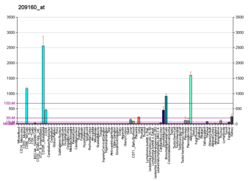Aldo-keto reductase family 1 member C3 (AKR1C3), also known as 17β-hydroxysteroid dehydrogenase type 5 (17β-HSD5, HSD17B5) or 3α-hydroxysteroid dehydrogenase type 2 (3α-HSD2)[5][6][7] is a steroidogenic enzyme that in humans is encoded by the AKR1C3 gene.[8][9][10]
- ^ a b c GRCh38: Ensembl release 89: ENSG00000196139 – Ensembl, May 2017
- ^ a b c GRCm38: Ensembl release 89: ENSMUSG00000021214 – Ensembl, May 2017
- ^ "Human PubMed Reference:". National Center for Biotechnology Information, U.S. National Library of Medicine.
- ^ "Mouse PubMed Reference:". National Center for Biotechnology Information, U.S. National Library of Medicine.
- ^ Zhang B, Zhu DW, Hu XJ, Zhou M, Shang P, Lin SX (May 2014). "Human 3-alpha hydroxysteroid dehydrogenase type 3 (3α-HSD3): the V54L mutation restricting the steroid alternative binding and enhancing the 20α-HSD activity". The Journal of Steroid Biochemistry and Molecular Biology. 141: 135–143. doi:10.1016/j.jsbmb.2014.01.003. PMID 24434280.
- ^ Li T, Zhang W, Lin SX (February 2020). "Steroid enzyme and receptor expression and regulations in breast tumor samples - A statistical evaluation of public data". The Journal of Steroid Biochemistry and Molecular Biology. 196: 105494. doi:10.1016/j.jsbmb.2019.105494. PMID 31610224.
- ^ Masiutin MM, Yadav MK (3 April 2023). "Alternative androgen pathways" (PDF). WikiJournal of Medicine. 10: 29. doi:10.15347/WJM/2023.003. S2CID 257943362.
 This article incorporates text from this source, which is available under the CC BY 4.0 license.
This article incorporates text from this source, which is available under the CC BY 4.0 license.
- ^ Khanna M, Qin KN, Wang RW, Cheng KC (August 1995). "Substrate specificity, gene structure, and tissue-specific distribution of multiple human 3 alpha-hydroxysteroid dehydrogenases". The Journal of Biological Chemistry. 270 (34): 20162–20168. doi:10.1074/jbc.270.34.20162. PMID 7650035.
- ^ Matsuura K, Shiraishi H, Hara A, Sato K, Deyashiki Y, Ninomiya M, et al. (November 1998). "Identification of a principal mRNA species for human 3alpha-hydroxysteroid dehydrogenase isoform (AKR1C3) that exhibits high prostaglandin D2 11-ketoreductase activity". Journal of Biochemistry. 124 (5): 940–946. doi:10.1093/oxfordjournals.jbchem.a022211. PMID 9792917.
- ^ EntrezGene 8644 AKR1C3 aldo-keto reductase family 1 member C3 [ Homo sapiens (human) ]






